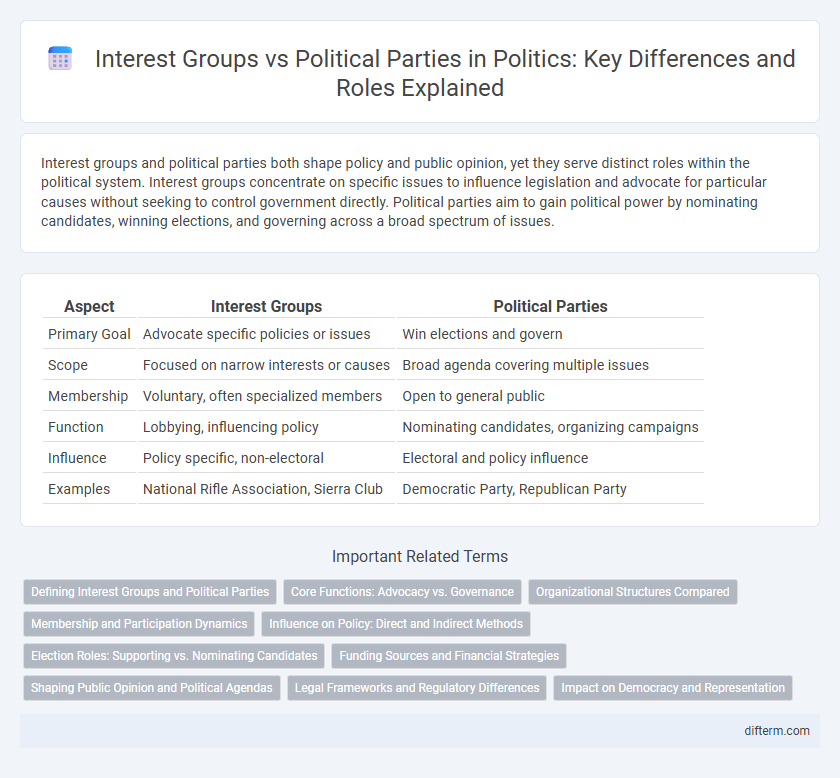Interest groups and political parties both shape policy and public opinion, yet they serve distinct roles within the political system. Interest groups concentrate on specific issues to influence legislation and advocate for particular causes without seeking to control government directly. Political parties aim to gain political power by nominating candidates, winning elections, and governing across a broad spectrum of issues.
Table of Comparison
| Aspect | Interest Groups | Political Parties |
|---|---|---|
| Primary Goal | Advocate specific policies or issues | Win elections and govern |
| Scope | Focused on narrow interests or causes | Broad agenda covering multiple issues |
| Membership | Voluntary, often specialized members | Open to general public |
| Function | Lobbying, influencing policy | Nominating candidates, organizing campaigns |
| Influence | Policy specific, non-electoral | Electoral and policy influence |
| Examples | National Rifle Association, Sierra Club | Democratic Party, Republican Party |
Defining Interest Groups and Political Parties
Interest groups are organized groups that seek to influence public policy and advocate for specific issues without directly seeking electoral office. Political parties are structured organizations aiming to gain political power by nominating candidates for public office and promoting a broad platform of policies. While interest groups focus on lobbying and influencing legislation, political parties concentrate on winning elections and governing.
Core Functions: Advocacy vs. Governance
Interest groups specialize in advocacy by influencing public policy and representing specific interests through lobbying and grassroots campaigns. Political parties focus on governance by organizing elections, formulating policy platforms, and managing government operations. While interest groups shape legislation externally, political parties implement policies internally once in power.
Organizational Structures Compared
Interest groups typically have specialized, decentralized organizational structures designed to mobilize focused constituencies and influence specific policy areas, whereas political parties maintain centralized, hierarchical frameworks aimed at broad voter engagement and candidate recruitment across multiple issues. Interest groups often employ expert staff and grassroots networks to advocate for narrow interests, while political parties coordinate large-scale campaigns and policy platforms. The structural differences reflect their distinct roles: interest groups emphasize advocacy and issue-specific lobbying, whereas political parties prioritize electoral competition and governance.
Membership and Participation Dynamics
Interest groups often maintain selective membership based on shared interests or causes, encouraging active participation through advocacy, lobbying, and grassroots mobilization. Political parties typically require broader membership to represent diverse constituencies and engage participants in candidate selection, campaigning, and voting activities. The participation dynamics differ as interest groups focus on issue-specific involvement while political parties emphasize electoral engagement and policy-making influence.
Influence on Policy: Direct and Indirect Methods
Interest groups influence policy through direct lobbying, providing expertise and campaign contributions to legislators, enhancing their access and sway over decision-making. Political parties affect policy indirectly by shaping electoral agendas, mobilizing voters, and controlling legislative priorities through party discipline and candidate selection. Both entities employ distinct strategies that complement each other in shaping public policy outcomes.
Election Roles: Supporting vs. Nominating Candidates
Interest groups play a critical role in elections by supporting candidates through endorsements, fundraising, and mobilizing voters without officially nominating them. Political parties exclusively nominate candidates to represent their platform, overseeing the selection process through primaries and conventions. This key distinction influences the structure of electoral competition and voter alignment in democratic systems.
Funding Sources and Financial Strategies
Interest groups primarily rely on membership dues, corporate donations, and specialized fundraising events to finance advocacy campaigns, whereas political parties secure funds through broad-based contributions, including small individual donations and large Political Action Committee (PAC) support. Political parties employ coordinated financial strategies such as bundling and comprehensive campaign financing to maximize electoral influence, while interest groups focus on targeted spending for lobbyists and issue-specific advertising. Regulatory frameworks like the Federal Election Commission (FEC) rules impose distinct contribution limits and disclosure requirements, shaping each entity's approach to fundraising and financial management.
Shaping Public Opinion and Political Agendas
Interest groups play a crucial role in shaping public opinion by mobilizing specific constituencies and providing detailed information on niche policy issues, whereas political parties aggregate broader interests to formulate comprehensive political agendas. Interest groups use targeted lobbying, grassroots campaigns, and media strategies to influence policymakers and public discourse, while political parties strategically craft platforms to unify diverse voter bases and drive electoral success. The dynamic interaction between interest groups and political parties ultimately shapes legislative priorities and the overall political landscape.
Legal Frameworks and Regulatory Differences
Interest groups operate within legal frameworks that emphasize lobbying regulations, campaign finance laws, and disclosure requirements distinct from political parties, which are governed by electoral laws and party registration statutes. Regulatory differences include stringent limits on donations and political activities for interest groups compared to broader freedoms political parties have in candidate endorsements and ballot access. These frameworks shape the strategic roles each entity plays in influencing policy and elections, with interest groups focusing on advocacy and political parties orchestrating electoral competition.
Impact on Democracy and Representation
Interest groups enhance democracy by providing specialized information and advocating for specific policy issues, ensuring diverse interests are represented beyond broad political party platforms. Political parties structure electoral choices and aggregate varying interests into comprehensive policy agendas that shape government direction. Both entities influence political representation, but interest groups focus on issue-specific advocacy while parties prioritize winning elections and governing.
interest groups vs political parties Infographic

 difterm.com
difterm.com